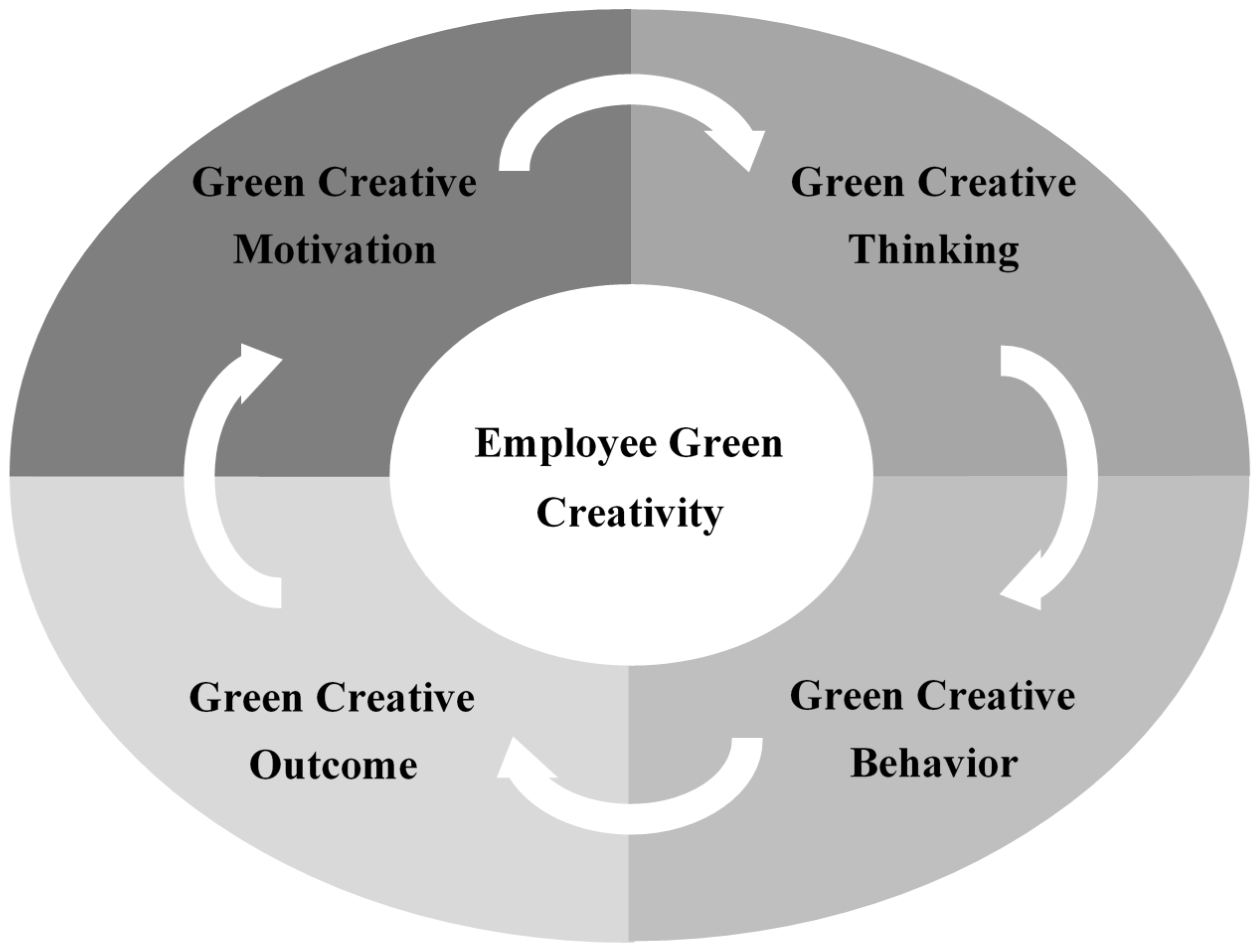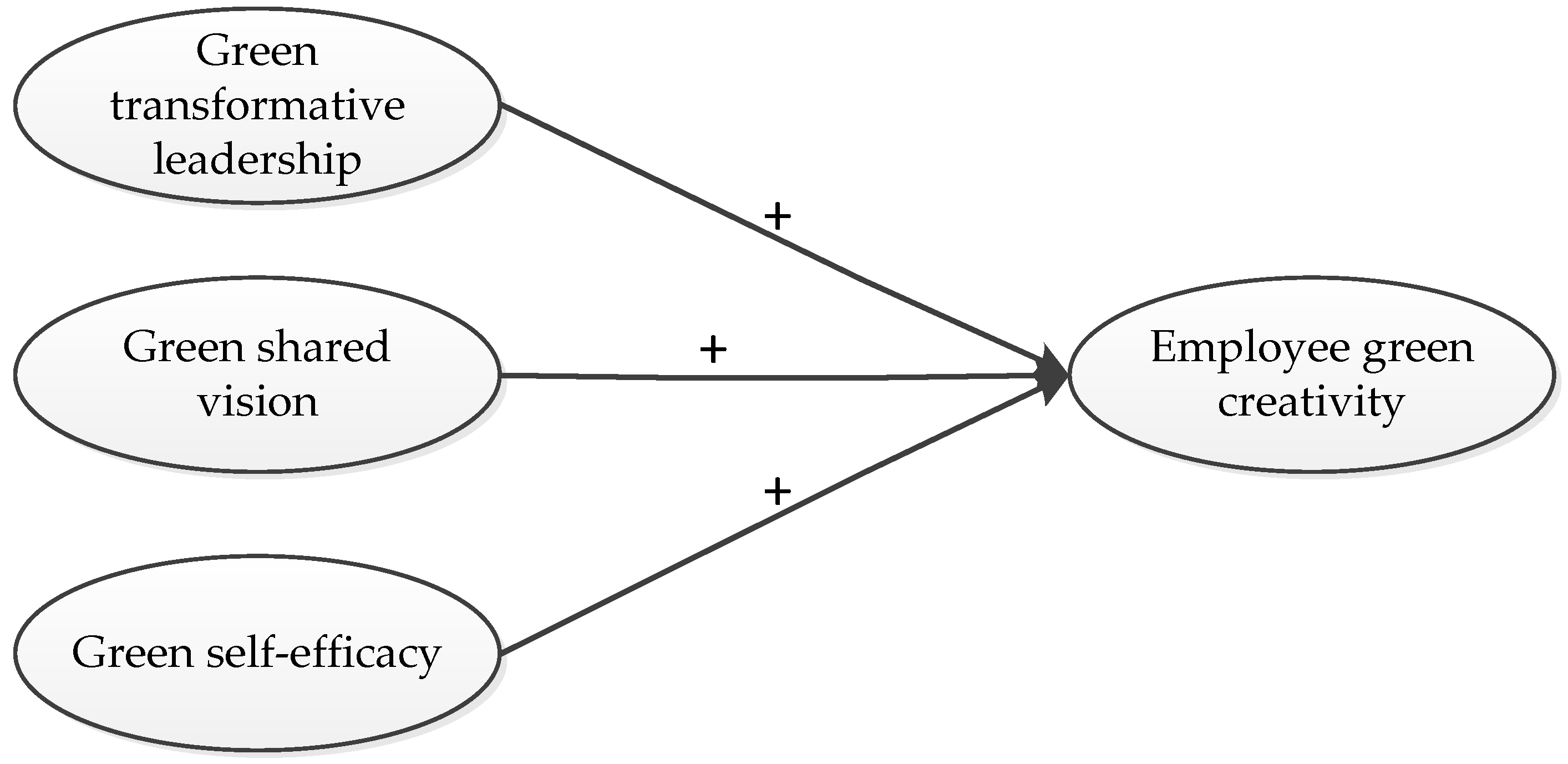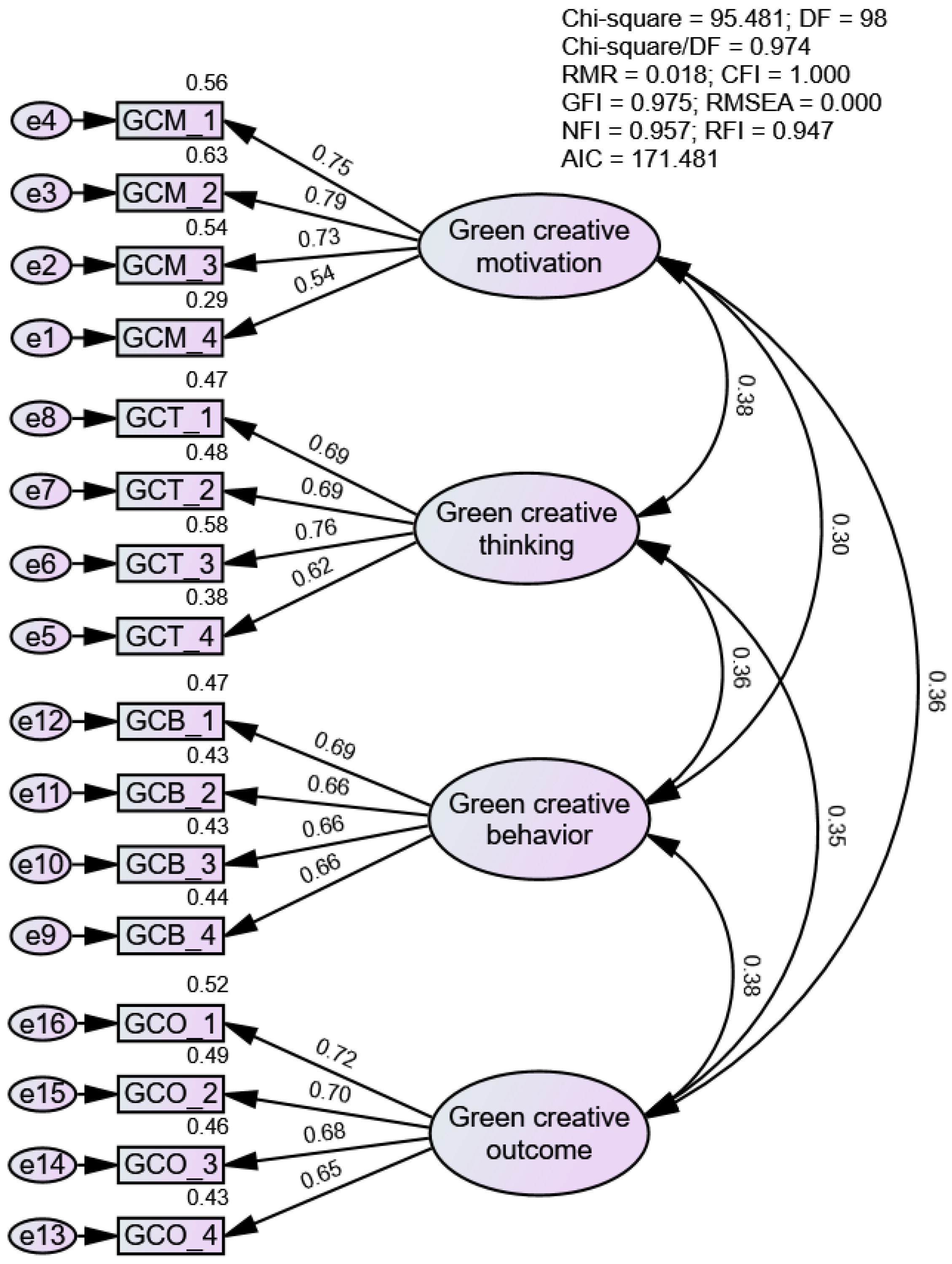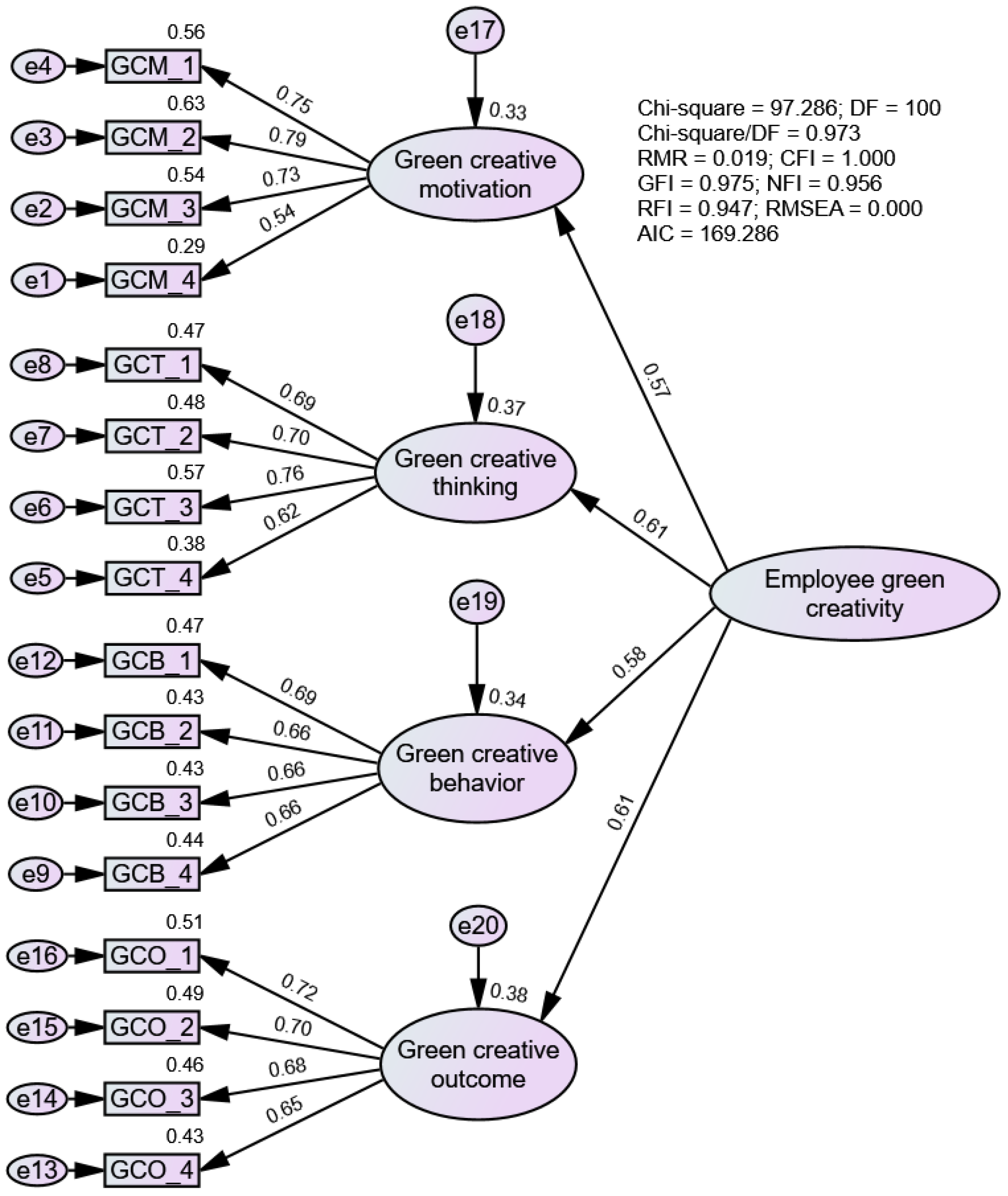Measuring Green Creativity for Employees in Green Enterprises: Scale Development and Validation
Abstract
1. Introduction
2. Theoretical Background
2.1. Literature Review: Green Creativity
2.2. Dimensions of Employee Green Creativity
2.3. Nomological Model of Employee Green Creativity
3. Materials and Methods
3.1. Initial Scale Construction
3.2. Scale Validation Analysis
3.2.1. Data Collection
3.2.2. Exploratory Factor Analysis
3.2.3. Confirmatory Factor Analysis
3.2.4. Second-Order Confirmatory Factor Analysis
3.3. Predictive Validity Analysis
3.3.1. Data Collection
3.3.2. Measures
3.3.3. Data Analysis
4. Conclusions and Discussion
4.1. Theoretical and Practical Implications
4.2. Limitations and Future Research
Author Contributions
Funding
Institutional Review Board Statement
Informed Consent Statement
Data Availability Statement
Conflicts of Interest
References
- Spielmann, N. Green is the new white: How virtue motivates green product purchase. J. Bus. Ethics 2020. [Google Scholar] [CrossRef]
- Grinevich, V.; Huber, F.; Karataş-Özkan, M.; Yavuz, Ç. Green entrepreneurship in the sharing economy: Utilizing multiplicity of institutional logics. Small Bus. Econ. 2017, 52, 859–876. [Google Scholar] [CrossRef]
- Chen, Y.S.; Chang, C.H. The determinants of green product development performance: Green dynamic capabilities, green transformational leadership, and green creativity. J. Bus. Ethics 2013, 116, 107–119. [Google Scholar] [CrossRef]
- Chen, Y.S.; Chang, C.H.; Yeh, S.L.; Cheng, H.I. Green shared vision and green creativity: The mediation roles of green mindfulness and green self-efficacy. Qual. Quant. 2015, 49, 1169–1184. [Google Scholar] [CrossRef]
- Chen, Y.S.; Chang, T.W.; Lin, C.Y.; Lai, P.Y.; Wang, K.H. The influence of proactive green innovation and reactive green innovation on green product development performance: The mediation role of green creativity. Sustainability 2016, 8, 966. [Google Scholar] [CrossRef]
- Song, W.; Yu, H. Green innovation strategy and green innovation: The roles of green creativity and green organizational identity. Corp. Soc. Resp. Environ. Manag. 2018, 25, 135–150. [Google Scholar] [CrossRef]
- Lozano, R. Creativity and organizational learning as means to foster sustainability. Sustain. Dev. 2014, 22, 205–216. [Google Scholar] [CrossRef]
- Awan, U.; Sroufe, R.; Kraslawski, A. Creativity enables sustainable development: Supplier engagement as a boundary condition for the positive effect on green innovation. J. Clean. Prod. 2019, 226, 172–185. [Google Scholar] [CrossRef]
- Jia, J.; Liu, H.; Chin, T.; Hu, D. The continuous mediating effects of GHRM on employees’ green passion via transformational leadership and green creativity. Sustainability 2018, 10, 3237. [Google Scholar] [CrossRef]
- Mittal, S.; Dhar, R.L. Effect of green transformational leadership on green creativity: A study of tourist hotels. Tour. Manag. 2016, 57, 118–127. [Google Scholar] [CrossRef]
- Amabile, T.M.; Conti, R.; Coon, H.; Lazenby, J.; Herron, M. Assessing the work environment for creativity. Acad. Manag. J. 1996, 39, 1154–1184. [Google Scholar]
- Shin, S.J.; Zhou, J. When is educational specialization heterogeneity related to creativity in research and development teams? Transformational leadership as a moderator. J. Appl. Psychol. 2007, 92, 1709–1721. [Google Scholar] [CrossRef] [PubMed]
- Amabile, T.M.; Pillemer, J. Perspectives on the social psychology of creativity. J. Creat. Behav. 2012, 46, 3–15. [Google Scholar] [CrossRef]
- Jagtap, S. Design creativity: Refined method for novelty assessment. Int. J. Des. Creat. Innov. Manag. 2018, 7, 99–115. [Google Scholar] [CrossRef]
- Fiorineschi, L.; Frillici, F.S.; Rotini, F. Impact of missing attributes on the novelty metric of Shah et al. Res. Eng. Des. 2020, 31, 221–234. [Google Scholar] [CrossRef]
- Sarkar, P.; Chakrabarti, A. Assessing design creativity. Des. Stud. 2011, 32, 348–383. [Google Scholar] [CrossRef]
- Fiorineschi, L.; Frillici, F.S.; Rotini, F. Issues Related to Missing Attributes in A-Posteriori Novelty Assessments. In Proceedings of the 15th International Design Conference, Dubrovnik, Croatia, 21–24 May 2018; pp. 1067–1078. [Google Scholar]
- Tariq, A.; Badir, Y.F.; Tariq, W.; Bhutta, U.S. Drivers and consequences of green product and process innovation: A systematic review, conceptual framework, and future outlook. Technol. Soc. 2017, 51, 8–23. [Google Scholar] [CrossRef]
- Suddaby, R. Editor’s comments: Construct clarity in theories of management and organization. Acad. Manag. Rev. 2010, 35, 346–357. [Google Scholar]
- Rhodes, M. An analysis of creativity. Phi Delta Kappan 1961, 42, 305–310. [Google Scholar]
- Tuan, L.T. Environmentally-specific servant leadership and green creativity among tourism employees: Dual mediation paths. J. Sustain. Tour. 2019, 28, 86–109. [Google Scholar] [CrossRef]
- Huo, W.; Li, X.; Zheng, M.; Liu, Y.; Yan, J. Commitment to human resource management of the top management team for green creativity. Sustainability 2020, 12, 1008. [Google Scholar] [CrossRef]
- Joshi, G.; Dhar, R.L. Green training in enhancing green creativity via green dynamic capabilities in the Indian handicraft sector: The moderating effect of resource commitment. J. Clean. Prod. 2020, 267, 121948. [Google Scholar] [CrossRef]
- Al-Ghazali, B.M.; Afsar, B. Green human resource management and employees’ green creativity: The roles of green behavioral intention and individual green values. Corp. Soc. Resp. Environ. Manag. 2020, 1–18. [Google Scholar] [CrossRef]
- Zhang, W.; Xu, F.; Wang, X. How green transformational leadership affects green creativity: Creative process engagement as intermediary bond and green innovation strategy as boundary spanner. Sustainability 2020, 12, 3841. [Google Scholar] [CrossRef]
- Yang, Z. Effect of workplace status on green creativity: An empirical study. Appl. Ecol. Environ. Res. 2019, 17, 8763–8774. [Google Scholar] [CrossRef]
- Prabhu, V.; Sutton, C.; Sauser, W. Creativity and certain personality traits: Understanding the mediating effect of intrinsic motivation. Creat. Res. J. 2008, 20, 53–66. [Google Scholar] [CrossRef]
- Auger, P.; Woodman, R.W. Creativity and intrinsic motivation: Exploring a complex relationship. J. Appl. Behav. Sci. 2016, 52, 342–366. [Google Scholar] [CrossRef]
- Shalley, C.E.; Zhou, J.; Oldham, G.R. The effects of personal and contextual characteristics on creativity: Where should we go from here? J. Manag. 2016, 30, 933–958. [Google Scholar] [CrossRef]
- Lonergan, D.C.; Scott, G.M.; Mumford, M.D. Evaluative aspects of creative thought: Effects of appraisal and revision standards. Creat. Res. J. 2004, 16, 231–246. [Google Scholar] [CrossRef]
- Lu, C.C. Interactive effects of environmental experience and innovative cognitive style on student creativity in product design. Int. J. Technol. Des. Educ. 2016, 27, 577–594. [Google Scholar] [CrossRef]
- Dreu, C.K.W.D.; Nijstad, B.A.; Baas, M. Behavioral activation links to creativity because of increased cognitive flexibility. Soc. Psychol. Pers. Sci. 2010, 2, 72–80. [Google Scholar] [CrossRef]
- Sethi, R.; Smith, D.C.; Park, C.W. Cross-functional product development teams, creativity, and the innovativeness of new consumer products. J. Mark. Res. 2001, 38, 73–85. [Google Scholar] [CrossRef]
- Paulus, P.B. Groups, teams, and creativity: The creative potential of idea-generating groups. Appl. Psychol. 2000, 49, 237–262. [Google Scholar] [CrossRef]
- Hsu, M.L.A.; Fan, H.L. Organizational innovation climate and creative outcomes: Exploring the moderating effect of time pressure. Creat. Res. J. 2010, 22, 378–386. [Google Scholar] [CrossRef]
- Horwitz, S.K.; Horwitz, I.B. The effects of team diversity on team outcomes: A meta-analytic review of team demography. J. Manag. 2007, 33, 987–1015. [Google Scholar] [CrossRef]
- Wang, X.; Zhou, K.; Liu, W. Value congruence: A study of green transformational leadership and employee green behavior. Front. Psychol. 2018, 9, 1946. [Google Scholar] [CrossRef]
- Amabile, T.M.; Schatzel, E.A.; Moneta, G.B.; Kramer, S.J. Leader behaviors and the work environment for creativity: Perceived leader support. Leadersh. Quart. 2004, 15, 5–32. [Google Scholar] [CrossRef]
- Gong, Y.; Huang, J.C.; Farh, J.L. Employee learning orientation, transformational leadership, and employee creativity: The mediating role of employee creative self-efficacy. Acad. Manag. J. 2009, 52, 765–778. [Google Scholar] [CrossRef]
- Shin, S.J.; Zhou, J. Transformational leadership, conservation, and creativity: Evidence from Korea. Acad. Manag. J. 2003, 46, 703–714. [Google Scholar] [CrossRef]
- Chen, Y.S.; Chang, C.H.; Lin, Y.H. The determinants of green radical and incremental innovation performance: Green shared vision, green absorptive capacity, and green organizational ambidexterity. Sustainability 2014, 6, 7787–7806. [Google Scholar] [CrossRef]
- Alt, E.; Díez-de-Castro, E.P.; Lloréns-Montes, F.J. Linking employee stakeholders to environmental performance: The role of proactive environmental strategies and shared vision. J. Bus. Ethics 2014, 128, 167–181. [Google Scholar] [CrossRef]
- Wu, C.M.; Chen, T.J. Collective psychological capital: Linking shared leadership, organizational commitment, and creativity. Int. J. Hosp. Manag. 2018, 74, 75–84. [Google Scholar] [CrossRef]
- Bell, B.S.; Kozlowski, S.W.J. Goal orientation and ability: Inter goal orientation and ability: Interactive effects on self-efficacy, performance, and knowledge. J. Appl. Psychol. 2002, 87, 497–505. [Google Scholar] [CrossRef] [PubMed]
- Churchill, G.A. A paradigm for developing better measures of marketing constructs. J. Mark. Res. 1979, 16, 64–73. [Google Scholar] [CrossRef]
- Hinkin, T.R. A brief tutorial on the development of measures for use in survey questionnaires. Organ. Res. Methods 2016, 1, 104–121. [Google Scholar] [CrossRef]
- Williams, B.; Onsman, A.; Brown, T. Exploratory factor analysis: A five-step guide for novices. J. Emerg. Prim. Health Care 2010, 8, 1–8. [Google Scholar] [CrossRef]
- Fornell, C.; Larcker, D.F. Evaluating structural equation models with unobservable variables and measurement error. J. Mark. Res. 1981, 18, 39–50. [Google Scholar] [CrossRef]
- Malhotra, N.K.; Dash, S. Marketing Research: An Applied Orientation; Pearson Publishing: London, UK, 2011. [Google Scholar]
- Wagenmakers, E.J.; Farrell, S. AIC model selection using Akaike weights. Psychon. B Rev. 2004, 11, 192–196. [Google Scholar] [CrossRef]
- Marsh, H.W.; Hocevar, D. Application of confirmatory factor analysis to the study of self-concept: First-and higher order factor models and their invariance across groups. Psychol. Bull. 1985, 97, 562–582. [Google Scholar] [CrossRef]
- Parjanen, S. Experiencing creativity in the organization: From individual creativity to collective creativity. Interdiscip. J. Inf. Knowl. Manag. 2012, 7, 109–128. [Google Scholar] [CrossRef]




| No. | Study | Classification of Green Creativity | ||||
|---|---|---|---|---|---|---|
| Green Creative Motivation | Green Creative Thinking | Green Creative Behavior | Green Creative Outcome | Unclassified | ||
| 1 | Chen and Chang [3] | — | — | — | Ideas about green products | — |
| 2 | Song and Yu [6] | — | Creative thinking | — | Green products | — |
| 3 | Jia et al. [9] | Green goal | — | Green behavior | Green products | — |
| 4 | Tuan [21] | Green value | Knowledge and skills | — | — | — |
| 5 | Huo et al. [22] | Willingness for green creativity | — | Green creativity behaviors | Green performance | — |
| 6 | Joshi and Dhar [23] | Green cognition | Skills and competence | Green behavior | — | Green training performance |
| 7 | Al-Ghazali and Afsar [24] | Green value | — | — | Green ideas | — |
| 8 | Zhang et al. [25] | — | — | Creative process engagement | Idea generation | — |
| 9 | Yang [26] | Environmental goal | — | — | Green product development performance | — |
| Items | M | SD | α | Factor Loadings | |||
|---|---|---|---|---|---|---|---|
| 1 | 2 | 3 | 4 | ||||
| 1. Green Creative Motivation (GCM) | 0.80 | ||||||
| (1) It makes me feel accomplished to engage in green-related creative works. | 4.94 | 0.77 | 0.81 | ||||
| (2) It makes me feel satisfied to engage in green-related creative works. | 5.03 | 0.76 | 0.80 | ||||
| (3) It is a great honor for me to engage in green-related creative works. | 4.98 | 0.68 | 0.81 | ||||
| (4) I consider engaging in green-related creative works to be an important activity. | 4.98 | 0.64 | 0.64 | ||||
| 2. Green Creative Thinking (GCT) | 0.78 | (0.30 **) | |||||
| (1) I can fluently think about green-related creative problems. | 4.95 | 0.72 | 0.73 | ||||
| (2) I can flexibly think about green-related creative problems. | 4.98 | 0.68 | 0.78 | ||||
| (3) I can elaborately think about green-related creative problems. | 5.00 | 0.71 | 0.80 | ||||
| (4) I can lastingly think about green-related creative problems. | 4.98 | 0.71 | 0.73 | ||||
| 3. Green Creative Behavior (GCB) | 0.76 | (0.25 **) | (0.28 **) | ||||
| (1) I can effectively cooperate with others for green-related creative works. | 5.02 | 0.82 | 0.75 | ||||
| (2) I can share green-related creative knowledge and skills with others. | 5.01 | 0.80 | 0.74 | ||||
| (3) I can arouse others’ green-related creative enthusiasm. | 5.02 | 0.76 | 0.76 | ||||
| (4) I can rapidly gain information on green-related creative works. | 5.03 | 0.81 | 0.73 | ||||
| 4. Green Creative Outcome (GCO) | 0.78 | (0.29 **) | (0.28 **) | (0.29 **) | |||
| (1) I can swiftly realize novel and useful green-related ideas. | 5.08 | 0.90 | 0.74 | ||||
| (2) I can realize high-quantity novel and useful green-related ideas. | 5.08 | 0.88 | 0.77 | ||||
| (3) I can realize high-quality novel and useful green-related ideas. | 5.02 | 0.87 | 0.78 | ||||
| (4) I can realize green-related novel and useful ideas with great value. | 5.07 | 0.83 | 0.73 | ||||
| CR | AVE | Construct | GCM | GCT | GCB | GCO |
|---|---|---|---|---|---|---|
| 0.80 | 0.51 | GCM | 0.71 | |||
| 0.79 | 0.48 | GCT | 0.38 | 0.69 | ||
| 0.76 | 0.44 | GCB | 0.30 | 0.36 | 0.66 | |
| 0.78 | 0.47 | GCO | 0.36 | 0.35 | 0.39 | 0.69 |
| Construct | M | SD | 1 | 2 | 3 | 4 | 5 | 6 | 7 | 8 | 9 | 10 | 11 | 12 | |
|---|---|---|---|---|---|---|---|---|---|---|---|---|---|---|---|
| 1 | Age | 31.27 | 7.20 | – | |||||||||||
| 2 | Gender | 0.55 | 0.50 | 0.08 | – | ||||||||||
| 3 | Education | 0.74 | 0.44 | −0.03 | 0.06 | – | |||||||||
| 4 | Tenure | 6.20 | 4.51 | 0.81 ** | 0.03 | −0.08 | – | ||||||||
| 5 | Green creative motivation | 4.72 | 0.80 | −0.11 | 0.13 | 0.09 | −0.09 | – | |||||||
| 6 | Green creative thinking | 5.07 | 0.69 | −0.25 ** | −0.06 | 0.09 | −0.24 ** | 0.24 ** | – | ||||||
| 7 | Green creative behavior | 4.51 | 1.13 | −0.32 ** | 0.00 | 0.08 | −0.28 ** | 0.15 * | 0.30 ** | – | |||||
| 8 | Green creative outcome | 5.23 | 0.87 | −0.24 ** | −0.00 | 0.18 * | −0.23 ** | 0.29 ** | 0.45 ** | 0.29 ** | – | ||||
| 9 | Employee green creativity | 4.89 | 0.60 | −0.35 ** | 0.03 | 0.16 * | −0.32 ** | 0.58 ** | 0.68 ** | 0.72 ** | 0.73 ** | – | |||
| 10 | Green transformational leadership | 5.45 | 0.93 | −0.06 | 0.11 | 0.20 ** | −0.08 | 0.31 ** | 0.29 ** | 0.15 * | 0.18 * | 0.33 ** | – | ||
| 11 | Green shared vision | 4.56 | 0.93 | −0.22 ** | 0.11 | 0.09 | −0.20 ** | 0.19 * | 0.15 | 0.23 ** | 0.26 ** | 0.31 ** | 0.23 ** | – | |
| 12 | Green self-efficacy | 5.10 | 0.66 | −0.20 ** | 0.03 | 0.09 | −0.17 ** | 0.24 ** | 0.35 ** | 0.19 * | 0.29 ** | 0.37 ** | 0.34 ** | 0.48 ** | – |
| Variables | DV = Employee Green Creativity | |||||
|---|---|---|---|---|---|---|
| Model 1 | Model 2 | Model 3 | ||||
| β | SE | β | SE | β | SE | |
| (Constant) | −0.00 | 0.07 | −0.00 | 0.07 | −0.00 | 0.07 |
| Age | −0.29 * | 0.12 | −0.24 * | 0.12 | −0.22 | 0.12 |
| Gender | 0.02 | 0.07 | 0.02 | 0.07 | 0.03 | 0.07 |
| Education | 0.09 | 0.07 | 0.12 | 0.07 | 0.12 | 0.07 |
| Tenure | −0.06 | 0.12 | −0.07 | 0.12 | −0.08 | 0.12 |
| Green transformational leadership | 0.29 ** | 0.07 | ||||
| Green shared vision | 0.23 ** | 0.07 | ||||
| Green self-efficacy | 0.31 ** | 0.07 | ||||
| R2 | 0.23 | 0.20 | 0.24 | |||
| F e | 9.47 ** | 7.96 ** | 10.05 ** | |||
Publisher’s Note: MDPI stays neutral with regard to jurisdictional claims in published maps and institutional affiliations. |
© 2020 by the authors. Licensee MDPI, Basel, Switzerland. This article is an open access article distributed under the terms and conditions of the Creative Commons Attribution (CC BY) license (http://creativecommons.org/licenses/by/4.0/).
Share and Cite
Jiang, H.; Wang, K.; Lu, Z.; Liu, Y.; Wang, Y.; Li, G. Measuring Green Creativity for Employees in Green Enterprises: Scale Development and Validation. Sustainability 2021, 13, 275. https://doi.org/10.3390/su13010275
Jiang H, Wang K, Lu Z, Liu Y, Wang Y, Li G. Measuring Green Creativity for Employees in Green Enterprises: Scale Development and Validation. Sustainability. 2021; 13(1):275. https://doi.org/10.3390/su13010275
Chicago/Turabian StyleJiang, Hui, Kaichao Wang, Zhibin Lu, Yifei Liu, Yu Wang, and Gang Li. 2021. "Measuring Green Creativity for Employees in Green Enterprises: Scale Development and Validation" Sustainability 13, no. 1: 275. https://doi.org/10.3390/su13010275
APA StyleJiang, H., Wang, K., Lu, Z., Liu, Y., Wang, Y., & Li, G. (2021). Measuring Green Creativity for Employees in Green Enterprises: Scale Development and Validation. Sustainability, 13(1), 275. https://doi.org/10.3390/su13010275




